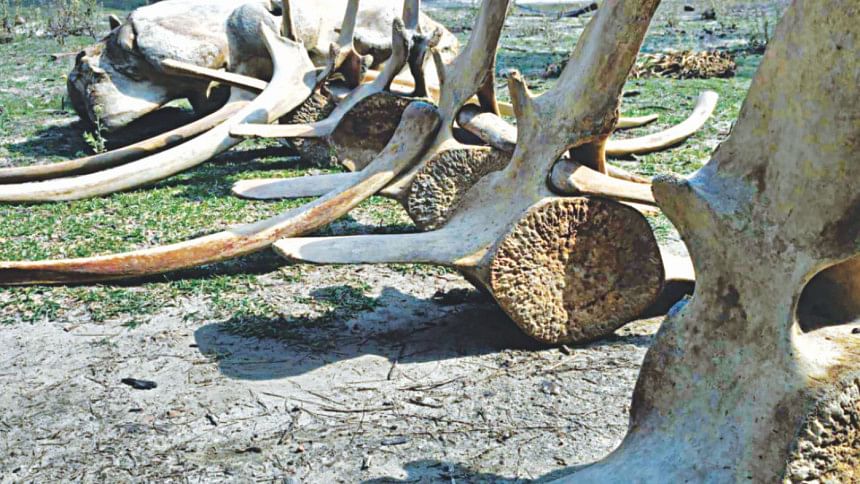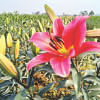Nature Quest: A sign hard to fathom

The Kotka beach in the Sundarbans is mostly empty apart from the plastic bottles and trash that wash ashore. Imagine the shock of forest guards who stumbled upon the rotting carcass of a 40-foot whale while patrolling the beach in August.
The forest officials had then directed the guards to protect the carcass. Ten months later, the skeleton of the whale is kept at a rundown corrugated iron-sheet office of the forest guards. The skeleton is so huge that just the head had to be lifted by four people. The head now lies on the veranda of the office.
Forest guard official Md Shohidul Islam said, "We guarded it for a month so that no one could steal anything from it. More than 10 people had to help us bring it to Kotka."
Experts have not officially identified the species. After inspecting photos of the whale, Rubaiyat M Mansur, country representative of Wildlife Conservation Society (WCS), said it could be a Baleen whale.
"It is difficult to determine the species from just a photo. But it is possibly a Baleen whale. This type of whale can be found in the Swatch of No Ground," he said.
The discovery of the whale carcass was not an isolated incident. Another whale was found washed up in Kuakata recently and last month fishermen found a 45-foot-long and 20-foot-wide marine mammal near the Kuakata eco-park area.
Such frequent findings are a possible indicator that the waters at our door step are rich in marine life.
Rubaiyat M Mansur said they have found a pod of whales 42km out in the ocean near Cox's Bazar coast. "We were amazed to see that there are whales near Cox's Bazar. It means our cost is rich in marine mammals."
Experts believe that there are mainly three reasons behind these findings of whale or marine mammal carcasses -- the marine mammals were either entangled in fishing nets; injured by the rudders or propellers of ships or were stranded from the submarine canyon Swatch of No-Ground, which is close to Kotka beach.
The movement of ships is increasing at Chittagong and Mongla ports, with nearly 2,500 vessels visiting these ports annually. Besides, industrial expansion in Mongla is aggravating the threat to marine life there.
The real reason behind the whale's death cannot be determined as Bangladesh lacks the technology required to ascertain such things.
Researchers in the USA, Australia, and Italy have given their verdict after analysing data on the impact of micro-plastics on whales, sharks and rays.
The researchers mentioned that the Bay of Bengal, the Gulf of Mexico, the Mediterranean Sea and the Coral Triangle were at risk and should be prioritised for monitoring.
Filter feeders swallow hundreds of cubic metres of water a day to capture their food from water and they may take in micro-plastics during the process. The study notes that possible risks include reduced nutritional uptake and damage to their digestive system.
However, whales are quite rare in the Bangladeshi coast because the water here is too shallow for their liking. They can be seen in Bangladesh's first marine protected area "Swatch of No-Ground".
This is not the first time a whale washed ashore in Bangladesh. The Chittagong District Gazetteer (1908) recorded one of the very first such incidents. According to the Gazetteer, the whale was found somewhere on the Chittagong coast in 1842. British era records say there have been several cases of whales getting stranded on the beach from 1842 to 1943.
In most cases, Baleen whales washed ashore. The WCS, during their research in Swatch of No-Ground, have come across numerous Baleen whales.
The mature supposedly Baleen whale carcass found in Kotka had no teeth. Baleen whales depend on schools of small fish and invertebrates like prawn. This sort of whale can be 40 to 50 feet long and are usually black or gray in colour.
While taking photos inside the building where the whale skeleton was being kept in Kotka, the structure shook a number of times. Pankaj Kumar Haldar, a forest guard of Kotka, said, "There is no other place to keep it. We know that the house is really risky. If a strong storm hits Kotka this year, the whole building may collapse."
Shams Tibrij, managing director of Bangladesh Tours and Travels, said every year at least 50,000 tourists visit the Sundarbans. "If the government takes necessary steps to preserve the skeleton, it could become a tourist attraction or be used for scientific purposes," he said.

 For all latest news, follow The Daily Star's Google News channel.
For all latest news, follow The Daily Star's Google News channel. 








Comments